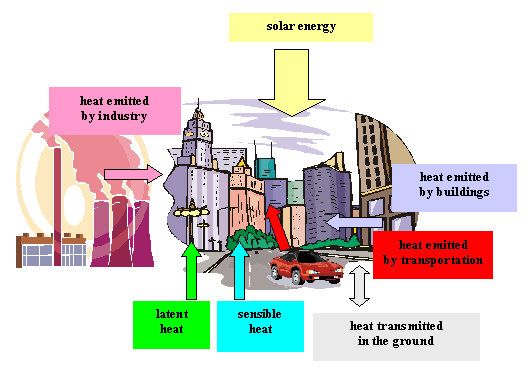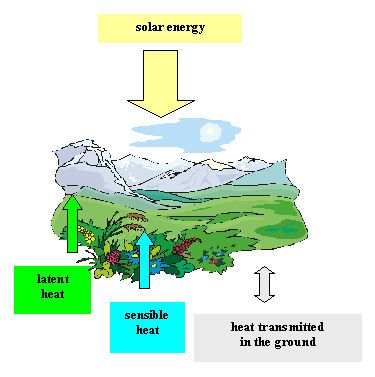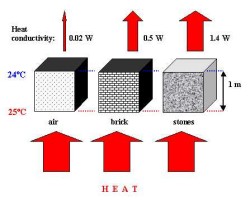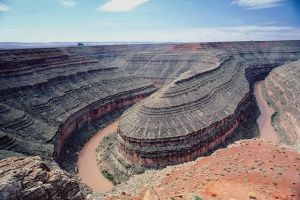 > ENC Master > Climate Encyclopaedia > Climate in Cities > more > 2. Urban Climate > - Heat
> ENC Master > Climate Encyclopaedia > Climate in Cities > more > 2. Urban Climate > - Heat
 |
|
|
|
Urban ClimateRead more |
Heat balance in a cityPeople living in a city sometimes have an impression that the city centre is warmer than the suburbs. How is air warmed in a city? What role is played by the buildings' structure (e.g. urban canyons)? |
|
The radiation balance and the heat balance are closely correlated with each other. First the short-wave solar radiation reaches the surface of the earth. A part of it is absorbed there and then emitted as a long-wave radiation (i.e. heat) to the atmosphere. Therefore, the air is mainly warmed by the ground, not directly by the Sun.
|
Natural surfaceThe heat balance of a given natural surface such as a meadow, is the difference between the energy gained and lost due to the exchange described by the following formula: Q + H + E + G = 0 where: |
|
|
The term "turbulent" means that the heat is transferred by turbulent air motions, i.e. random and continuously changing air motions, which are superposed on the mean motion of the air.
|
|
Please note that during a day-time, the signs are different than during the night-time, indicating the direction of heat transfer: Day-time: the air is colder than the ground (it warms more slowly), so the heat transfer tends to diminish the difference and warm the air, the radiation stream (Q) is directed from the ground toward the atmosphere (positive value): Q - H - E - G = 0 Night-time: there is no sunshine and no energy delivery to the Earth surface, the heat will go from atmosphere to the ground (Q has the negative value). Usually, during a night, the ground cools more than the air, as the air cools more slowly: - Q + H + E + G = 0 |
Urban surfaceThe heat balance of an urban area is more complex due to the volume of buildings. Thus, the heat balance for an urban area must include a storage term Qp for heat which includes heat exchange by the conduction in ground, streets, walls of the buildings: Q + Qp + H + E + Qf = 0 as well as a term Qf to represent the anthropogenic heat delivered to the atmosphere mainly during combustion of fossil fuels. Please note that we do not take here into account the influence of the air masses coming to the city and also bringing some heat, i.e. the influence of advection, but if we assume that a city is a rather uniform landuse type area, then the advection is negligible. |
 |
|
3. Heat emitted to the atmosphere in a city
|
Urban canyons
|
|
|
|
An important element of urban structure are so-called urban canyons, i.e. streets with rows of high buildings on both sides, analogous to river canyons. The amount of solar radiation received by an urban canyon as a whole depends on the height of the buildings and on the orientation of the canyon. Further, the properties of the materials used for the construction of buildings and streets are important, not only due to their thermal admittance, but also in terms of their short-wave reflectivity or albedo. A phenomenon known as solar trapping can occur in canyons whereby the solar radiation is reflected off many surfaces within the canyon, thus allowing more opportunity for absorption (have a look at the concept of sky view factor). About 60% of the net all-wave radiation is released to the air as sensible heat and 30% is stored in the walls and streets. Only the remaining 10% is used for evaporation, as the artificial surfaces do not store water like natural ones do, and there is usually little green areas in a city. However, the mentioned numbers may vary for different cities due to amount of greenspace, irrigation etc.
|
|
Related pages: The radiation balance is discussed in detail in: |
|
About this page:Authors: Sebastian Wypych, Anita Bokwa - Jagiellonian University - Cracow / Poland |





